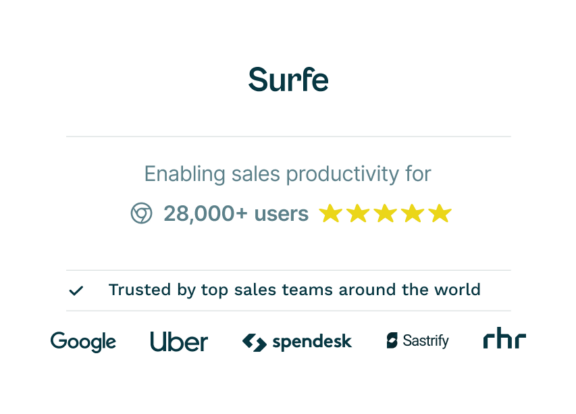How to Master Cold Calling Without Sounding Like a Script

Rank these in order of terrifying-ness:
- A huge spider
- A clown
- A cold call
What was at the top of your list? As a sales professional, you’d probably say cold calling shouldn’t even be on that list – but 63% of you also view it as an unfavorable task.
Honestly, we get it. We all know how hard it is to get anyone to pick up the phone these days. And once you actually do manage to speak to your prospect, you’ve got to guide the conversation to its conclusion without things feeling natural or forced.
In this situation, lots of sales professionals rely on scripts. Not sure what to say? No problem: the script will tell you!
The problem here is that scripts sound like, well, scripts. And nothing’s going to turn a prospect off like feeling like they’re speaking to a robot who *gasp* doesn’t actually know anything about them.
Scripts may feel like a comfort blanket but they don’t do you, or your prospects, any favors. Instead, you want to be nailing cold calls without them – which is where this blog post comes in:
- The Problem with Scripted Cold Calls
- Steps to Sound Natural and Confident
- Common Cold Calling Mistakes to Avoid
- Cold Calling Techniques That Work
- Key Metrics to Track for Cold Calling Success
Once you’ve finished reading you’ll be able to make a cold call that feels natural and personal, and most importantly, gets the job done.
Ready? Let’s go👇
The Problem with Scripted Cold Calls
Have you ever read off a script while conducting a cold call and found that the person at the other end of the phone…doesn’t seem to be following it?
That’s basically the problem with scripted cold calls summed up right there. Scripts only work perfectly when you know what the other person is going to say. Which, unfortunately, isn’t going to happen.
The result? You sound a bit like a robot that’s programmed to say the same thing – no matter what the person you’re speaking to is actually saying.
People can tell when you read from a script – and this isn’t good for your relationship. People like to feel special. Reading from a script is going to make them feel the opposite, and damage your image as someone they should trust in the process.
To dig a little deeper here, scripted calls often fail to address the prospect’s specific needs (as these – duh – will be unique to the prospect). 42% of sales reps feel they lack enough information before making a call. And scripts may seem like a solution, but really they’re just a stop-gap measure.
Now, we’re not saying that you need to ditch the script altogether. Having something to fall back on is good – but you need to start viewing scripts as a flexible guide rather than something to follow word-for-word.
Steps to Sounding Natural and Confident
The key to sounding natural and confident is to reduce your reliance on scripts. But what on earth do you do instead?
Step 1: Focus on Building Rapport Early
First of all, you want to focus on building rapport. This helps to break down barriers between you and make the conversation feel personal, rather than transactional.
We’d recommend using friendly, open-ended questions to start the call. Showing a genuine interest in the prospect’s business, pain points, or recent achievements. For example, you could ask:
- “I noticed your company just expanded – how’s that going for you?”
- “What’s been the most difficult thing for you to tackle recently?”
- “How have you been managing [industry problem]?”
The more you can build trust with your prospect, the better – after all, 87% of business buyers expect sales reps to act as trusted advisors.
Step 2: Prepare a Flexible Outline, Not a Word-for-Word Script
A flexible outline, rather than a word-for-word script, gives you the comfort of having something to fall back on without forcing you into an awkward, mechanical conversation.
Prepare some key points or questions to guide the conversation, but make space for a natural flow. The key here is active listening: make sure you actually understand what they’re telling you, and respond thoughtfully. Your outline should have enough breathing room to allow for the conversation to develop organically.
The nice thing about this approach is it leads to a highly personalized conversation. The best businesses close 30% of qualified leads. Treat this conversation as a qualification process and the right results will follow.
Step 3: Use Open-Ended Questions
We’re sure you know this already – but the key to a good conversation is avoiding questions with a yes/no answer. Open-ended questions allow the conversation to flow and invite the prospect to share more, which gives you more of an opportunity to learn about them. Examples of open-ended questions include:
- “What challenges are you currently facing with your current provider?”
- “How do you usually approach solving this issue?”
- “What goals are you focussed on achieving over the next quarter?
It’s also worth remembering that you might not find out everything you need to know during one call (unless you have a really, really chatty prospect). 44% of sales professionals give up after just one follow-up call – missing an opportunity for deeper engagement over time.
Step 4: Personalize the Pitch Based on Research
Before a call, you should do your research alongside preparing your outline. Knowing specific details about a prospect’s business will help you tailor your pitch and keep things super relevant.
When it comes to research, LinkedIn is your very best friend. Spend some time looking into the company and its decision-makers – their personal profiles should tell you about what they’re interested in, what products they use, and their career journeys so far.
It’s also worth checking out industry press – keep an eye out for any news you could use as a talking point, or perhaps the business your targeting has recently gone through a relevant change or a fundraising round.
Tip: doing your research goes both ways. 75% of B2B purchasers won’t talk to a salesperson until they’ve done some prior investigation. Make sure your own LinkedIn profile is up-to-date and clearly states what you do and what you’re about.
Common Cold Calling Mistakes to Avoid
By now you should be feeling well-prepared and ready to jump into a cold call. But wait – find out about common pitfalls first.
Talking Too Much
Talking too much is an easy thing to do when you’re nervous – but it can be pretty harmful. Overloading the prospect with information can feel pushy and make it difficult for them to engage. After all, if they can’t get a word in edgeways they’re not going to be able to tell you anything, are they?
The fix: aim for a balanced conversation where your prospect talks for 40-50% of the time at a minimum. If there’s a pause, don’t rush to fill it too quickly – chances are your prospect will and will end up telling you something interesting instead.
Ignoring Objections
It can be frustrating when you’re nailing a cold call and the prospect interrupts with an (in your eyes) pointless objection. But that’s not a license to be dismissive – ever. All you’re going to do is end up with a bigger objection at a later (and potentially more vital) part of the sales process.
Approach the objection from a place of empathy and active listening to understand what they’re telling you. Maybe you need to explain a certain benefit a little more or go deeper on why your pricing structure is what it is.
The fix: acknowledge their concerns and ask follow-up questions to make sure you understand their objection. From there you’ll be in a far better position to address it.
- Why it’s Harmful: Dismissing objections makes the prospect feel unheard and can shut down the conversation.
- Fix: Acknowledge their concerns and ask follow-up questions to address them directly. → only going to harm you in the long run if you don’t
Not Following Up
If you reach out to a perfect lead and then fail to follow up, you’re essentially leaving a potential deal on the table.
Following up can be difficult – even more so if you’re cold calling a high volume of leads, or didn’t didn’t get the outcome you hoped for from your first call – but it should be an essential part of your repertoire. It often takes 8 attempts to reach a prospect. There’s no need to be discouraged if you don’t succeed straight away!
The fix: we’d recommend scheduling follow-ups immediately, so you don’t miss out on a potentially great deal.
Cold Calling Techniques That Work
Once you’ve got the basics down, you can start experimenting with different cold calling techniques. Play around with the below – you might find that one works for you, or maybe it’s a combination of all three.
Technique 1: Mirroring the Prospect’s Tone
When you get along with or feel close to someone, you’ll end up naturally mirroring them – their body language, the way they speak or what they say. You can use this to your advantage by intentionally introducing a bit of mirroring into the conversation.
Why it works: mirroring helps you align with your prospect’s communication style, making the conversation feel more comfortable. For example, if you’re formal you can adopt a similar tone; or if they’re casual you can match that.
Technique 2: Emphasizing Value Over Features
You might have the most technically brilliant product in the world, but be honest: do your prospects really care about how innovative the tech is? Or do they just want their problem to be solved? We’ll take a bet that it’s the latter.
Why it works: at the end of the day, your product isn’t their product. Lead with the benefits of your product, and you’re getting straight to the crux of what’s important for your prospect. For example, instead of talking about your “AI-powered features”, say “This will help you cut your reporting time in half”.
Technique 3: Using Silence Strategically
We’ve touched on this briefly already. Lean into a pause and you’re likely to learn something interesting from the prospect.
Why it works: a pause gives the prospect space to think and contribute actively. This leads to a more balanced conversation. It’s an easy technique to implement too: after asking a question or addressing an objection, wait for them to respond instead of filling the gap yourself.
Key Metrics to Track for Cold Calling Success
As with all your processes, you should be carefully tracking your cold calling efforts to work out what is (or isn’t) working. Metrics to keep an eye on include:
Call-to-appointment conversion rate: measure how many cold calls result in scheduled appointments – the industry benchmark sits at around the 2% mark.
Average call duration: If calls are too short, it’s likely that you need to dial down on engaging your prospects more. Overly long calls suggest that the conversation isn’t as focused as it could be.
Follow-up rate: multiple follow-ups are a sign of success here. If you’re only following up once or twice, you’re not giving your prospects the attention they need.
Response rate: track how many prospects respond – over email or by ringing you back – after a call, which can show how effective the approach is.
Let’s Wrap It Up!
Go right ahead and cross cold calling off the scary list. By now, you should be feeling ready to tackle your next one – safe in the knowledge that you’re not going to sound like a robot.
Do your research, focus on sounding natural and confident, track your progress, and you’ll be moving prospects to the next stage left, right and center. Keep an eye out for our next blog post on tackling clowns – coming soon.*

*ok, maybe not coming THAT soon…
Why not check out Surfe while you wait? After all, how else are you going to find the phone numbers to cold call?
FAQs About Mastering Cold Calling Without Sounding Like a Script
What Are the Best Cold Calling Techniques for Building Authentic Connections?
Try these cold calling techniques on your next call to build a connection with your prospect:
- Mirror your prospect: lightly mirror what your prospect says or the tone they’re using, and you’ll create a feeling of rapport and closeness.
- Emphasize value over features: make sure you focus on the value your prospect will gain over the features they’ll use. Most prospects want to know about the end result rather than the why.
- Make use of silences: lean into silence, and you’re giving your prospect time to think and to give a thoughtful answer. Leaving them to fill the gaps increases your chances of learning something new.
How Can Cold Calling Scripts Be Modified to Sound More Natural and Conversational?
The best way to modify a cold calling script is to turn it into an outline. Use it as a rough guide for the conversation rather than something to read out word-by-word, and you’ll give the conversation a lot more room to develop naturally.
What Are Common Cold Calling Mistakes and How Can I Avoid Them?
Common cold calling mistakes to avoid include:
- Talking too much: silence is (in the right amounts) golden. Your prospect should be talking around 40-50% of the time.
- Ignoring objections: you’ll only set yourself up for a bigger objection later down the line if you ignore it from the get-go. Practice active listening, ask open-ended questions to learn more and then address it as best you can.
- Not following up: it takes on average 8 tries to reach a prospect through cold call, so make sure to schedule follow-ups in advance.


